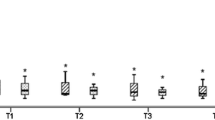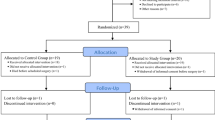Abstract
Background
During laparoscopy, pneumoperitoneum may result in intraoperative atelectasis, which impairs normal gas exchange. This study investigated whether positive end-expiratory pressure (PEEP) of 5 cmH2O in pressure-controlled ventilation (PCV) mode can improve ventilatory and oxygenation parameters during pneumoperitoneum.
Methods
Thirty patients, aged 18–65 years, undergoing laparoscopic cholecystectomy were randomly allocated to the ZEEP (PEEP = 0 cmH2O) or PEEP (PEEP = 5 cmH2O) group. PCV was started after induction of anesthesia. Apart from PEEP level, all other ventilator settings were identical for both groups. Peak airway pressure was set at induction and reset after pneumoperitoneum to deliver tidal volume of 8 ml/kg in both groups. Hemodynamic, ventilatory, and oxygenation parameters were measured after induction of anesthesia (T1) and 30 min after pneumoperitoneum (T2).
Results
Oxygenation index (PaO2/FiO2) was significantly higher in the PEEP group than in the ZEEP group at T2 (P = 0.031). In both groups, dynamic compliance significantly decreased over 40 min from T1 to T2. There were no significant differences in hemodynamics between the two groups during the study period.
Conclusion
Application of PEEP of 5 cmH2O should be considered in PCV during laparoscopic surgeries to decrease intraoperative atelectasis caused by pneumoperitoneum to improve gas exchange and oxygenation.

Similar content being viewed by others
References
Sharma KC, Brandstetter RD, Brensilver JM, Jung LD (1996) Cardiopulmonary physiology and pathophysiology as a consequence of laparoscopic surgery. Chest 110:810–815
Hong JY, Chung KH, Lee YJ (1999) The changes of ventilatory parameters in laparoscopic colecystectomy. Yonsei Med J 40:307–312
Cadi P, Guenoun T, Journois D, Chevallier JM, Diehl JL, Safran D (2008) Pressure-controlled ventilation improves oxygenation during laparoscopic obesity surgery compared with volume-controlled ventilation. Br J Anaesth 100:709–716
Balick-Weber CC, Nicolas P, Hedreville-Montout M, Blanchet P, Stéphan F (2007) Respiratory and haemodynamic effects of volume-controlled vs. pressure-controlled ventilation during laparoscopy: a cross-over study with echocardiographic assessment. Br J Anaesth 99:429–435
Meininger D, Byhahn C, Mierdl S, Westphal K, Zwissler B (2005) Positive end-expiratory pressure improves arterial oxygenation during prolonged pneumoperitoneum. Acta Anaesthesiol Scand 49:778–783
Hazebroek EJ, Haitsma JJ, Lachmann B, Bonjer HJ (2002) Mechanical ventilation with positive end-expiratory pressure preserves arterial oxygenation during prolonged pneumoperitoneum. Surg Endosc 16:685–689
Hardman JG, Aitkenhead AR (1999) Estimation of alveolar deadspace fraction using arterial and end-tidal CO2: a factor analysis using a physiological simulation. Anaesth Intensive Care 27:452–458
Mercat A, Graïni L, Teboul JL, Lenique F, Richard C (1993) Cardiorespiratory effects of pressure-controlled ventilation with and without inverse ratio in the adult respiratory distress syndrome. Chest 104:871–875
Davis K Jr, Branson RD, Campbell RS, Porembka DT (1996) Comparison of volume control and pressure control ventilation: is flow waveform the difference? J Trauma 41:808–814
Al-Saady N, Bennett ED (1985) Decelerating inspiratory flow waveform improves lung mechanics and gas exchange in patients on intermittent positive-pressure ventilation. Intensive Care Med 11:68–75
Guyton AC, Hall JE (1996) Transport of oxygen and carbon dioxide in the blood and body fluids. In: Saunders W (ed) Textbook of Medical Physiology, 9th edn. Elsevier, Philadelphia, pp 513–523
McKibben AW, Ravenscraft SA (1996) Pressure-controlled and volume-cycled mechanical ventilation. Clin Chest Med 17:395–410
Duggan M, Kavanagh BP (2005) Pulmonary atelectasis: a pathogenic perioperative entity. Anesthesiology 102:838–854
Andersson LE, Bååth M, Thörne A, Aspelin P, Odeberg-Wernerman S (2005) Effect of carbon dioxide pneumoperitoneum on development of atelectasis during anesthesia, examined by spiral computed tomography. Anesthesiology 102:293–299
Kraut EJ, Anderson JT, Safwat A, Barbosa R, Wolfe BM (1999) Impairment of cardiac performance by laparoscopy in patients receiving positive end-expiratory pressure. Arch Surg 134:76–80
Loeckinger A, Kleinsasser A, Hoermann C, Gassner M, Keller C, Lindner KH (2000) Inert gas exchange during pneumoperitoneum at incremental values of positive end-expiratory pressure. Anesth Analg 90:466–471
Ekman LG, Abrahamsson J, Biber B, Forssman L, Milsom I, Sjoqvist B (1988) Hemodynamic changes during laparoscopy with positive end-expiratory pressure ventilation. Acta Anaesthesiol Scand 32:447–453
Disclosures
Drs. Ji Young Kim, Cheung Soo Shin, Hong Soon Kim, Wol Sun Jung, and Hyun Jeong Kwak have no conflicts of interest or financial ties to disclose.
Author information
Authors and Affiliations
Corresponding author
Rights and permissions
About this article
Cite this article
Kim, J.Y., Shin, C.S., Kim, H.S. et al. Positive end-expiratory pressure in pressure-controlled ventilation improves ventilatory and oxygenation parameters during laparoscopic cholecystectomy. Surg Endosc 24, 1099–1103 (2010). https://doi.org/10.1007/s00464-009-0734-6
Received:
Accepted:
Published:
Issue Date:
DOI: https://doi.org/10.1007/s00464-009-0734-6




